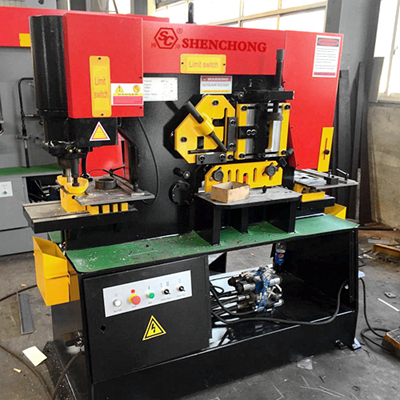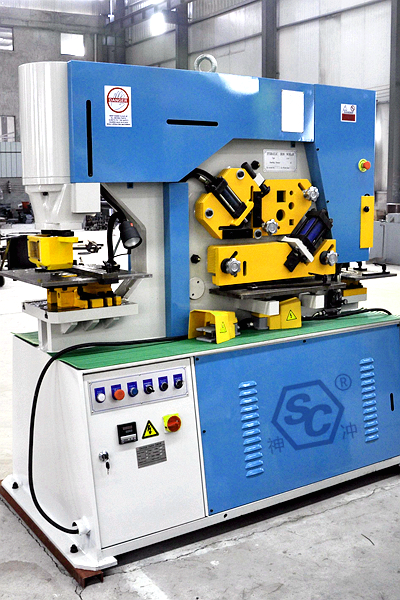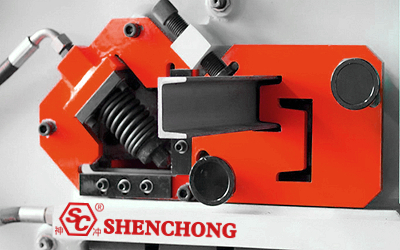

The ironworker punching and shearing machine is a multifunctional device that integrates various functions of sheet metal and profile processing equipment.
The hydraulic ironworker machine is widely used not only in the processing of steel structures and storage shelves, but also in the production of High-voltage cable towers, street lamps, elevators, ventilation ducts and other civilian facilities due to its superior performance, increasing application fields and expanding application scope.
When shearing and punching machines are used for raw materials such as angle iron, round steel, round steel, square steel pipes, etc. of metal profiles, a ironworker machine is often used. This equipment integrates various functions and has the functions of shearing, punching machine, die shear, and irregular cutting. It is a common metal profile punching and shearing machine at present.

When the ironworker punching and shearing machine is working, the electric motor drives the large belt pulley (usually also used as a flywheel) through a triangular belt, and drives the crank slider mechanism through a gear pair and clutch, causing the slider and punch to go down in a straight line.
After the forging work is completed, the slider returns upward, the clutch automatically disengages, and the brake on the crank shaft is engaged, causing the slider to stop near the top dead center.
Each crank slider mechanism is called a "point". The simplest mechanical punching and shearing machine adopts a single point type, which only has a crank slider mechanism.
Some large working face mechanical presses use two-point or four-point systems to ensure uniform force on the bottom surface of the slider and smooth movement.
The load of the ironworker punching and shearing machine is impulsive, that is, the forging and pressing work time is very short within a working cycle. The maximum power for a short time is more than ten times greater than the average power, so flywheels are installed in the transmission system.
After the motor selected according to the average power is started, the flywheel runs to the rated speed and accumulates kinetic energy.
After the punch contacts the blank and begins forging work, the driving power of the motor is less than the load, the speed decreases, and the flywheel releases the accumulated kinetic energy for compensation.
After the forging work is completed, the flywheel accelerates again to accumulate kinetic energy for future use.
There is a mechanical or electrical interlock between the clutch and the brake on the ironworker punching and shearing machine to ensure that the brake is released before the clutch is engaged and the clutch is disengaged before the brake is applied.
The operation of mechanical pressure is divided into continuous, single stroke, and inching (micro movement), most of which are achieved by controlling the clutch and brake.
The stroke length of the slider remains unchanged, but the distance between its bottom surface and the working surface (referred to as the sealing height) can be adjusted by the screw.
During production, there is a possibility of exceeding the nominal working force of the press. To ensure equipment safety, overload protection devices are often installed on the press. In order to ensure the personal safety of the operator, the press machine is equipped with photoelectric or manual personal protection devices.

Sometimes when applying ironworker punching and shearing machines, we should follow appropriate methods to operate them in practice, so that the ironworker punching and shearing machine can fully exert its necessary functions. Below is an introduction to how to operate the ironworker punching and shearing machine correctly.
- Wear labor protection equipment before production to remove obstacles and maintain smoothness.
- The lubrication of each transmission part should be sufficient, and each lubrication point should be refueled 2-3 times per shift.
- The cutting tooling and punching tooling should be intact, free from cracks, and firmly fastened.
- The gap between the punch and the tooling hole wall should be uniform and meet the requirements of punching and shearing. The minimum configuration of the punch should slightly exceed the plane of the tooling hole.
- The electrical insulation and grounding of the equipment are good.
- Check whether the covers and shells of each safety protection device are intact and fixed. After confirming their firmness, start the empty vehicle for trial operation. After confirming that they are normal, production can only begin.
- The operator must be familiar with the equipment performance, electrical knowledge, and proficient in operating procedures of the ironworker punching and shearing machine. They must be responsible by a dedicated person and trained before taking up their job.
- Check the power supply, ensure that all control operation switches are in good condition, and that the foot switch is not disconnected. Open the ironworker punching and shearing machine wiring cabinet to power on and close the cabinet door.
- After completing the power on inspection, drive the vehicle empty for trial operation, and also check whether the emergency stop switch can function. Production can only be carried out after confirming normal conditions.
- Turn off the power every time the tooling is changed.
- After completing the work, turn off the switch, turn off the main power switch, and clean the debris.
- Punching and cutting of steel plates, round steel, square steel, and section steel can be carried out simultaneously, but two types of steel cannot be cut at the same time.
- Cutting quenched steel and processing beyond equipment capacity are strictly prohibited.
- The cutting tool and blade should be kept sharp, and the blade should be replaced in a timely manner if it becomes blunt or cracks.
- When cutting steel plates, round steel, square steel, and section steel, they must be tightly pressed.
- During equipment operation, it is strictly prohibited to touch the surface of rotating parts with hands, measure workpieces, and directly clean leftover materials with hands.
- When leaving the machine tool, the operator must stop the machine and check that the original positions of the handles in each part remain unchanged before driving again.
- Do not cut laminated sheets, do not trim the edges of rough edge sheets, and do not cut narrow and short sheets that are not tightly pressed.
- When two or more people work together, there must be someone in charge to command the action.
- When feeding, the fingers must be 200mm away from the blade, and special tools must be used for small parts.
- The operator should concentrate, and it is strictly prohibited to connect the vehicle or load materials from the opposite side of the control lever.
- Strictly follow the operating procedures for operation.
Of course, in the long-term use process, we also need to do a good job in the daily maintenance of the ironworker punching and shearing machine, which can ensure that it has always played an excellent performance in the long-term use process.
- Before starting the machine every day, add lubricating oil at a fixed time, location, and quantity according to the lubrication chart requirements, and the oil should be clean and free of sediment.
- The ironworker punching and shearing machine must be kept clean regularly, and the unpainted parts must be protected against rust and grease.
- The lubricating oil in the motor bearing shall be regularly replaced and filled, and the electrical equipment shall be regularly checked for normal, safe and reliable operation.
- Regularly inspect the triangular belt, handle, knob, and button of the ironworker punching and shearing machine for damage. If they are severely worn, they should be replaced in a timely manner and reported as spare parts for supplementation.
- Regularly inspect and repair switches, fuses, and handles to ensure their reliable operation.
- Add oil, lubricate, scrub, and clean the machine tool 10 minutes before leaving work every day.
- During maintenance or repair work, the power supply of the equipment must be turned off.
- Make special records of the overall performance of the equipment and hand them over to the workers who take over the shift.
- Maintain a clean and hygienic environment around the cutting machine, and clean the logistics after work.
You may also want to know:
Multi-Function Ironworker Machine Applications and Technical Regulations